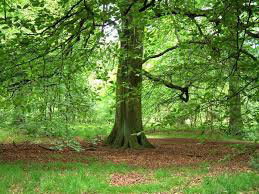 |
| This Diagram shows the two key elements of the tree that can effect your Barbecue results. Smokinlicious® only harvest wood from the heartwood of the tree. |
Should I cook with bark on woods or go bark-free?
I’ve heard all kinds of reasoning for leaving the bark on: it burns up right away so you don’t need to worry. It’s what gives the flavor to foods. It’s what gives the color to smoked and grilled foods. It is the essence of BBQ!Well, my intention is to simply provide you with more detail about what is in the bark and then you can decide for yourself if you want to include it in your wood fired cooking method.
What Is Bark?
There are two types of bark in every tree: living bark which is called phloem and dead bark called rhytidome. For today’s discussion, I am only focusing on the rhytidome or dead bark which is the outer bark layer.Outer bark’s main purpose is to protect the wood tissues against mechanical damage and preserve the wood tissues from temperature and humidity variations. Bark chemistry is much more complicated than wood tissue chemistry but let’s cover the basics.
Chemistry of Bark
Outer bark has high concentrations of pectin, phenolic compounds, and minerals. Although the exact chemical levels vary by species, location of the tree, age of the tree, and growth conditions of the tree, let me list some of the common extractives:ethyl ether – a common laboratory solvent as well as a starter fluid component
dichloromethane – common compound used in paint strippers and degreasers as well as to decaffeinate coffees and teas
calcium oxalate crystals – a calcium salt found in plant materials with a link to kidney stones in humans
Air Pollutant Meter
For many years, university and research facilities around the world have used tree bark as a bio-indicator of air pollutant levels as bark is highly porous, rough, and high in lipids making its surface ideal for absorption. It’s been proven that tree bark soaks up airborne gases and particles. In fact, in my own home state of New York, the Niagara Falls area trees have been noted to have significantly higher levels of Dechlorane Plus, a flame retardant chemical that is produced by a factory in that city. How much higher? Several thousand times higher!After many decades of non-regulated chemical use in various products – think pesticides, flame retardants, building material preservatives, etc. – and with the subsequent halting of production of many of these highly toxic chemicals in the 1980s and 90s, research now shows that as those chemicals evaporated, they became air borne particles. Those particles landed and were absorbed by the outer tree bark.
Temperature Fluctuation
My experience with bark-on woods used for the intended purpose of cooking has been that bark results in temperature control issues. Often, when the bark combusts it does so in variable levels, producing a short burst of elevated temperature. This is likely due in part, to the chemical air pollutant particles that have settled into the outer bark layer. Knowing that bark harbors impurities that the tree is exposed to, I hypothesize that there likely are other particles, likely transferred via air as well as direct contact from the carrier (think animals, humans, etc.), that are absorbed by the tree’s bark.Change of Taste
Just as lighter fluid can add unpleasant or at the very least a distinct taste difference in foods cooked over product lit with lighter fluid, I caution that some of you will also find an off taste to foods cooked over bark-on woods.If you are lucky enough to have a source of wood within your own property, that has no neighborly contact with chemical industry, and you feel confident that the bark-on wood is safe, then the choice to cook with it may be easy. If, however, you rely on an outside source say a firewood supplier, you may want to rethink cooking over that bark-on product or at the very least, take the time to rid the bark.



